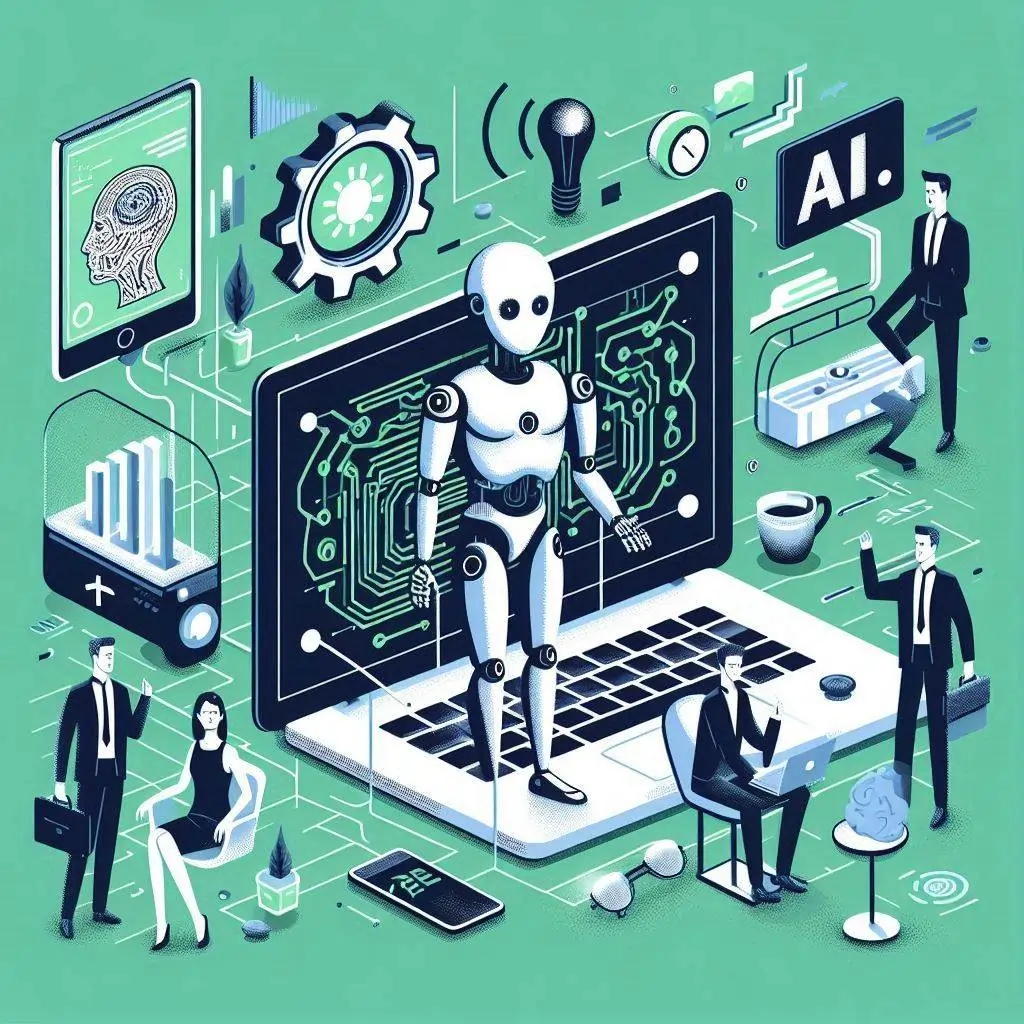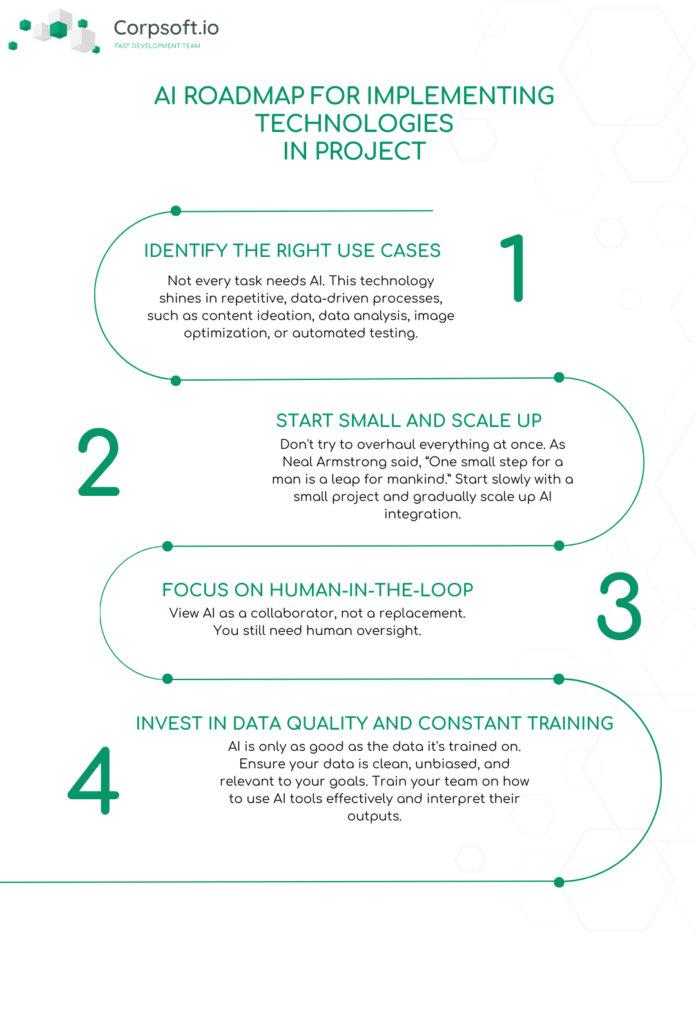
Why You Don’t Need To Rush Full-Scale AI Implementation
In today’s fiercely competitive landscape, it’s vital to use all innovations among the firsts. It saves you time and money so that you can do even more work during the same period. We know that you are constantly looking for ways to boost your business, and AI technology is definitely a technology that will help in the long run.
Curious about how to create the most profitable AI implementation strategy for your business without messing it up? Check this article to find out whether it’s worth it to run AI for your business.
AI Implementation In the IT Industry
AI is currently used in different branches of IT, radically changing the flow of things throughout the industry. Grammarly’s recent layoff reflects those changes, and there will be hundreds or even thousands of similar cases in the next few years.
AI implementation in business in the IT industry affects all its aspects, from internal management and development to marketing and all external communications. AI can automate a wide range of IT processes, such as provisioning and configuration management, security monitoring, and data center operations. It can save quality assurance (QA) and service management time by identifying and solving issues, predicting potential risks, and answering user questions.
Many AI solutions for businesses provide content generation and improvement tools to facilitate the marketing department’s workflow. AI tools can write texts like blog posts, social captions, and video scenarios. Those services can proofread content for grammar and style issues, check for plagiarism, and even suggest sentence structure and clarity improvements. However, any technology has its fly in the ointment. AI is not the exception.
Why You Shouldn’t Rush With AI Integration: Web Development Dangers
Artificial intelligence implementation is not a panacea. It’s still a new technology with its limitations. It still uses patterns, even if you don’t see it. Meanwhile, in web development, you still need to “see the bigger picture” to edit existing or create completely new solutions. Even the best AI solution still can’t do it. You need an expert who can review the tiniest details and have a vision of the project.
AI tools learn from human code. Sometimes it has bugs. Yep, you understand it right. It can write your code with minor bugs without even understanding it. While a human can find and resolve its code problems, AI will just say “Hey, everything is OK. IDK why you are so angry.”
Also, most AI tools won’t help you edit the complex code on a working service with a ton of interconnected infrastructure. You still need someone to review and edit the code even after AI implementation.
Remember that any tool is only as good as the data it’s trained on. So, AI services can be too biased, which can become problematic in web development. A human developer can identify and mitigate bias to ensure a fair and inclusive user experience.
If not implemented carefully, AI technology can introduce new security vulnerabilities. Even the best AI strategy framework can’t altogether remove those risks. You still need a human to review everything.
Why It’s Risky To Launch A Full-Scale AI Implementation In Creative Departments
Creative departments (marketing, content, and human resources) also use new services with artificial intelligence. However, we don’t recommend relying solely on generative AI implementation. You should still have experts in your team.
Creative experts can add the ✨spark ✨ into the content, while AI tools will provide formulaic and clichéd text and photos. Moreover, social media and Google can already distinguish AI-made content and lower your positions.
Other big problems in machine learning and AI are biased algorithms and workforce disruption concerns. AI algorithms can perpetuate biases present in the data they’re trained on, leading to discriminatory outcomes. For instance, an AI-powered resume screener trained on biased data might unfairly filter out qualified candidates.
As this worldwide AI implementation automates even more originally human tasks, some jobs may become obsolete. It can lead to unemployment and economic hardship for certain workforce sectors. Mass layoffs lower the buying power, so businesses will earn less and need to fire even more staff.
Implementing AI tools, especially in creative departments, can be expensive. Poorly planned projects can lead to wasted resources. It could be due to:
- Choosing the wrong AI tool. If you need to generate high-quality pictures, it’s better to use a Dall-e, not Google Gemini.
- Not properly integrating AI into business workflows. Copy-paste doesn’t work. Search engines can find AI-generated content and ban it. An expert still needs to fact-check and rewrite it.
- Failing to consider ongoing maintenance costs. Most AI tools are paid, so if you need it just from time to time, it can draught your budget. It will be more economically justified to collaborate with teams who use this tool daily.
But what to do, if you still want to try new tools and don’t have AI experience? How to create your own enterprise AI strategy? Is it even possible? Yes, you still can use new AI-based tools to boost your productivity. It just needs a little shaping. To the salon!
Is There Any AI Implementation Strategy To Catch Benefits Without Pitfalls?
Each new technology has a period when it was taken as “society’s threat.” It started when the first hominids decided to use a stone instead of their bare hands. Modern times are no exception. If you want smooth AI integration into your business, follow next steps:

By following this AI roadmap, you’ll ensure that your project will use the latest technologies while remaining a safe and efficient space.
Wrapping Up: What Should You Do While Building an AI Strategy
While thinking about AI implementation, tell yourself why you need it in the first place. Usually, it’s an “I want my team to be more productive and/or save some money along the way” kind of situation. In this case, the most beneficial option for you is to teach your staff to use the AI tools while remaining human-centric.
If you want to save up without teaching your staff AI tools, you can collaborate with expert development teams like Corpsoft.io. They already know where to use AI to fasten work processes and where businesses should rely only on the experts. By collaborating with expert teams from Eastern Europe, you’ll get access to professionals who know the latest EU and US regulations while living in a similar cultural context as you do.
Contact the Corpsoft.io team to safely implement AI solutions into your business!
Subscribe to our blog

